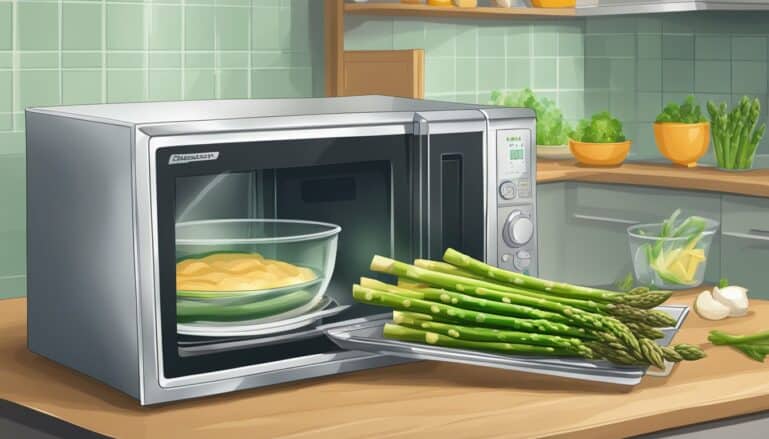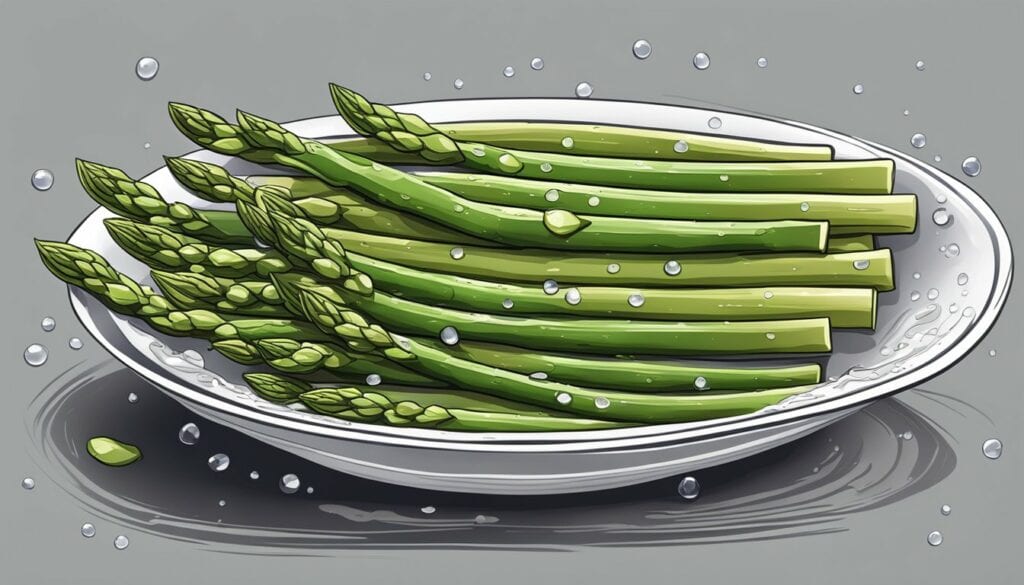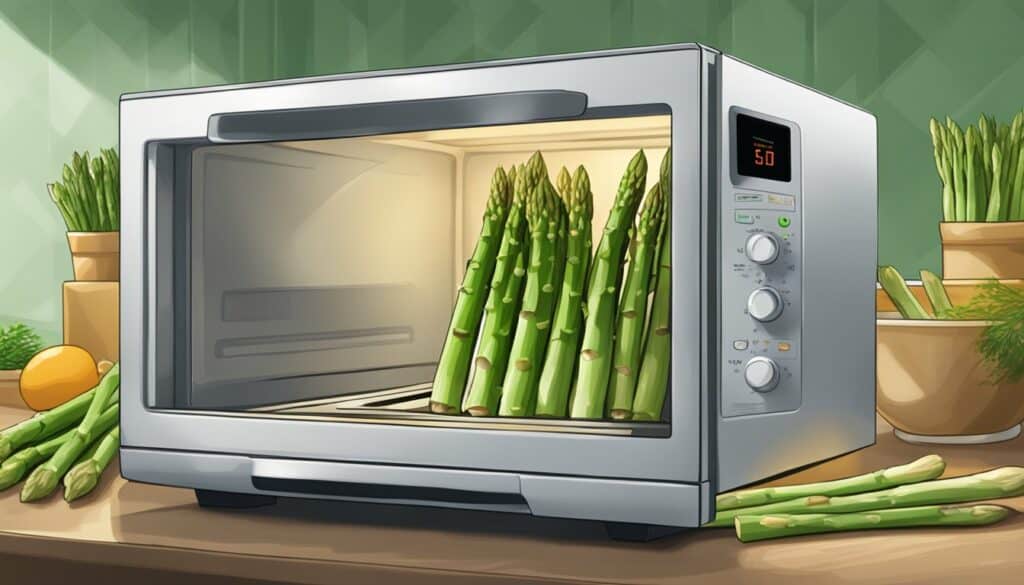How to Cook Asparagus in the Microwave: A Quick and Easy Guide

Table of Contents
Understanding Asparagus
Asparagus is a green vegetable that is known for its tender stalks and unique flavor. When cooking asparagus in the microwave, it is important to understand the characteristics of this vegetable to achieve the best results.
- Asparagus is a delicate vegetable that can easily become overcooked and lose its tender texture.
- Thin asparagus is more delicate than thicker stalks and will require less cooking time.
- Asparagus is a great source of vitamins and minerals, including vitamins A, C, E, and K, as well as folate and potassium.
- Overcooking asparagus can cause it to become mushy and lose its bright green color.
- Asparagus is a versatile vegetable that can be used in a variety of dishes, including salads, soups, and stir-fries.
By understanding the characteristics of asparagus, you can ensure that your microwave-cooked asparagus is tender, flavorful, and perfectly cooked every time.
Nutritional Value of Asparagus
Asparagus is a nutrient-dense vegetable that is low in calories and high in several important vitamins and minerals. Here are some of the key nutritional benefits of asparagus:
-
Vitamins and minerals: Asparagus is an excellent source of vitamin C, vitamin K, folate, and potassium. It also contains small amounts of iron, calcium, and vitamin E.
-
Fiber: Asparagus is a good source of dietary fiber, which can help promote digestive health and keep you feeling full and satisfied.
-
Low in calories: One cup of cooked asparagus contains only about 30 calories, making it a great choice for those watching their calorie intake.
-
Low in fat: Asparagus is naturally low in fat and contains no saturated fat or cholesterol.
-
Low in sodium: Asparagus is naturally low in sodium, which can help promote heart health and lower blood pressure.
-
Antioxidants: Asparagus contains antioxidants like vitamins C and E, which can help protect your cells from damage caused by free radicals.
Overall, asparagus is a healthy and nutritious vegetable that can be a great addition to any diet. Whether you’re looking to lose weight, improve your heart health, or simply enjoy a delicious and nutritious vegetable, asparagus is a great choice.
Selecting and Preparing Asparagus
When selecting asparagus, I always go for the freshest ones available. Look for firm, bright green spears with tightly closed tips. The asparagus should also be straight and not too thick. Thicker asparagus tends to be less tender and more fibrous.
Before cooking, it’s important to wash the asparagus thoroughly to remove any dirt or sand. I usually rinse them under cold running water and then pat them dry with a paper towel.
To prepare the asparagus, I like to use a vegetable peeler to remove the tough outer layer of the bottom part of the spears. This helps to ensure that the asparagus cooks evenly and is more tender. Simply hold the asparagus by the tip and run the peeler down the stalk, removing a thin layer of skin.
Once the asparagus has been washed and peeled, it’s ready to be cooked. Microwave cooking is a quick and easy way to prepare asparagus, and it retains more of its nutrients than other cooking methods.

Ingredients for Microwave Asparagus
To cook asparagus in the microwave, you will need the following ingredients:
- Fresh asparagus spears
- Salt
- Butter
- Garlic
- Pepper
- Lemon juice
- Parmesan cheese
I recommend using Kosher salt, as it has a coarser texture than table salt and will stick better to the asparagus. You can also use garlic salt or onion powder for additional seasoning.
When selecting asparagus, look for firm, straight spears with tightly closed tips. Avoid any that are wilted or have slimy tips.
Before cooking, rinse the asparagus under cold water and trim off the woody ends. You can do this by bending the spear until it snaps, or by cutting off the bottom inch or two.
Once you have your ingredients and prepared asparagus, you’re ready to start cooking!
Microwave Cooking Method
To cook asparagus in the microwave, I prefer using a microwave-safe dish or bowl. Here are the steps to follow:
- Wash the asparagus and trim the tough ends.
- Place the asparagus in a microwave-safe dish or bowl.
- Add 1-2 tablespoons of water to the dish or bowl.
- Cover the dish or bowl with a microwave-safe lid or plastic wrap.
- Microwave on high for 3-5 minutes, depending on the thickness of the asparagus.
- Check the asparagus for doneness. It should be tender but still crisp.
- Remove the dish or bowl from the microwave and carefully remove the lid or plastic wrap.
- Serve hot with your favorite seasoning or sauce.
Microwave cooking is a quick and easy method to cook asparagus without losing its nutrients. It is also a great option when you need to save time in the kitchen. Just make sure to use a microwave-safe dish or bowl, and always follow the recommended cooking time for your microwave.
Steaming Asparagus in the Microwave
To steam asparagus in the microwave, I recommend using a damp paper towel to help create a steaming effect. Here’s how I do it:
- Rinse the asparagus and trim off the woody ends.
- Place the asparagus in a microwave-safe dish.
- Add a small amount of water to the dish, just enough to cover the bottom.
- Cover the dish with a damp paper towel.
- Microwave on high for 3-4 minutes, or until the asparagus is tender and cooked through.
Be careful when removing the dish from the microwave, as it will be hot. Remove the paper towel and serve the steamed asparagus immediately.
Using a damp paper towel helps to create a steaming effect, which cooks the asparagus evenly and helps to retain its nutrients. Plus, it’s a quick and easy way to cook asparagus without having to use a separate steamer or pot.
Overall, steaming asparagus in the microwave is a convenient and healthy way to enjoy this delicious vegetable.
Avoiding Common Mistakes
When cooking asparagus in the microwave, it’s important to avoid common mistakes that can result in mushy or overcooked asparagus. Here are a few tips to help you get it right:
- Don’t overcook the asparagus: Overcooking asparagus can result in a mushy texture and a loss of flavor. To avoid overcooking, start with a shorter cooking time and check the asparagus frequently to see if it’s done to your liking.
- Don’t add too much water: Adding too much water to the dish can result in steamed asparagus that is limp and overcooked. Instead, use just enough water to cover the bottom of the dish and create steam.
- Don’t overcrowd the dish: Overcrowding the dish can result in uneven cooking and mushy asparagus. Instead, spread the asparagus out in a single layer to ensure even cooking.
- Don’t forget to season: Asparagus can be bland if not properly seasoned. Add a sprinkle of salt and pepper or your favorite seasoning blend to enhance the flavor.
By following these tips, you can avoid common mistakes and cook delicious asparagus in the microwave every time.
Serving Suggestions
Asparagus is a versatile vegetable that can be served in many ways. Here are a few serving suggestions to try:
-
As a side dish: Asparagus makes a great side dish for any meal. Simply season with salt and pepper, and microwave until tender. Serve alongside your favorite protein, such as grilled chicken or fish.
-
In salads: Asparagus adds a fresh and crunchy texture to salads. Try mixing it with greens, cherry tomatoes, and a light vinaigrette for a healthy and flavorful salad.
-
With hollandaise sauce: Hollandaise sauce is a classic pairing for asparagus. Drizzle the sauce over the cooked asparagus for a decadent side dish.
-
With white wine: Asparagus pairs well with white wine, such as Sauvignon Blanc or Pinot Grigio. Serve a chilled glass alongside your meal for a refreshing and sophisticated touch.
-
In pasta dishes: Asparagus can also be used in pasta dishes. Try tossing cooked asparagus with your favorite pasta, olive oil, garlic, and Parmesan cheese for a simple yet delicious meal.
Overall, asparagus is a versatile vegetable that can be served in many ways. Experiment with different flavors and serving suggestions to find your favorite way to enjoy this nutritious vegetable.

Storing and Reheating Leftovers
When storing leftover cooked asparagus, it is important to keep it in an airtight container in the refrigerator. This will help preserve its freshness and prevent it from drying out. Leftover cooked asparagus can last for up to 4 days in the refrigerator.
When reheating leftover asparagus, the microwave is a quick and easy option. Simply place the asparagus in a microwave-safe dish and cover it with a damp paper towel. This will help prevent the asparagus from drying out while it reheats.
Microwave the asparagus on high for 30 seconds to 1 minute, or until it is heated through. Be careful not to overheat the asparagus, as this can cause it to become mushy.
If you prefer a different reheating method, you can also reheat the asparagus in a skillet with a little bit of butter or oil. This will help bring back some of its original flavor and texture.
In summary, storing leftover cooked asparagus in an airtight container in the refrigerator can help preserve its freshness for up to 4 days. When reheating, the microwave is a quick and easy option, but be sure to cover the asparagus with a damp paper towel and avoid overcooking it. Alternatively, you can reheat the asparagus in a skillet with a little bit of butter or oil for added flavor.
Alternative Cooking Methods
When it comes to cooking asparagus, the microwave is not the only option available. Here are some alternative cooking methods to try:
Grilled Asparagus
Grilling asparagus is a great way to add a smoky flavor to the vegetable. To grill asparagus, simply brush it with olive oil and sprinkle with salt and pepper. Place the asparagus on a preheated grill and cook for about 5-7 minutes, turning occasionally, until it is tender and slightly charred.
Boiled Asparagus
Boiling asparagus is a quick and easy way to cook it. Simply bring a pot of salted water to a boil, add the asparagus, and cook for 2-3 minutes, or until it is tender but still crisp. Drain the asparagus and serve immediately.
Oven-Roasted Asparagus
Oven-roasting asparagus is a great way to bring out its natural sweetness. To roast asparagus, preheat your oven to 425°F. Toss the asparagus with olive oil, salt, and pepper, and spread it out in a single layer on a baking sheet. Roast for 10-15 minutes, or until the asparagus is tender and slightly browned.
Roasted Asparagus
Roasting asparagus is another great way to add flavor to the vegetable. To roast asparagus, preheat your oven to 400°F. Toss the asparagus with olive oil, salt, and pepper, and spread it out in a single layer on a baking sheet. Roast for 15-20 minutes, or until the asparagus is tender and slightly browned.
Overall, there are many ways to cook asparagus, and each method brings out a different flavor and texture. Experiment with different cooking methods to find your favorite way to enjoy this delicious vegetable.
Dietary Considerations
When it comes to cooking asparagus in the microwave, there are a few dietary considerations to keep in mind. Here are some tips to help you make the most of your asparagus while still sticking to your dietary needs.
Low-Carb
Asparagus is naturally low in carbohydrates, making it a great choice for those following a low-carb diet. When cooking asparagus in the microwave, avoid adding any high-carb ingredients like potatoes or grains. Instead, try seasoning your asparagus with olive oil, salt, and pepper for a simple yet delicious low-carb dish.
Gluten-Free
Asparagus is naturally gluten-free, so you don’t need to worry about any gluten-containing ingredients when cooking it in the microwave. However, if you’re using any pre-made seasoning blends, be sure to check the label for any hidden sources of gluten.
Keto
Asparagus is also a great choice for those following a keto diet. It’s low in carbs and high in fiber, making it a great addition to any keto meal. When cooking asparagus in the microwave, try using butter or ghee instead of olive oil for a delicious keto-friendly flavor.
Overall, asparagus is a versatile and healthy vegetable that can be enjoyed by many different dietary needs. With these tips in mind, you can confidently cook asparagus in the microwave while still staying true to your dietary goals.
Asparagus Recipes
I love cooking asparagus in the microwave because it’s quick and easy. Here are a few of my favorite asparagus recipes that you can make in the microwave:
-
Lemon Garlic Asparagus: Cut the asparagus into 2-inch pieces and place them in a microwave-safe dish. Drizzle with olive oil and sprinkle with minced garlic, salt, and pepper. Squeeze a fresh lemon over the top. Cover the dish with plastic wrap and microwave on high for 3-4 minutes, or until the asparagus is tender.
-
Parmesan Asparagus: Cut the asparagus into 2-inch pieces and place them in a microwave-safe dish. Drizzle with olive oil and sprinkle with salt and pepper. Microwave on high for 2-3 minutes, or until the asparagus is tender. Sprinkle grated Parmesan cheese over the top and microwave for an additional 30 seconds, or until the cheese is melted.
-
Bacon-Wrapped Asparagus: Wrap each asparagus spear with a slice of bacon and place them in a microwave-safe dish. Microwave on high for 4-5 minutes, or until the bacon is crispy and the asparagus is tender.
These asparagus recipes are perfect for a quick and healthy side dish. Try them out and let me know which one is your favorite!